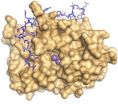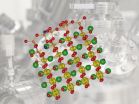(Press-News.org) CALI, COLOMBIA (3 MARCH 2014)—A comprehensive new study of global food supplies confirms and thoroughly documents for the first time what experts have long suspected: over the last five decades, human diets around the world have grown ever more similar—by a global average of 36 percent—and the trend shows no signs of slowing, with major consequences for human nutrition and global food security.
"More people are consuming more calories, protein and fat, and they rely increasingly on a short list of major food crops, like wheat, maize and soybean, along with meat and dairy products, for most of their food," said lead author Colin Khoury, a scientist at the Colombia-based International Center for Tropical Agriculture (CIAT), which is a member of the CGIAR Consortium. "These foods are critical for combating world hunger, but relying on a global diet of such limited diversity obligates us to bolster the nutritional quality of the major crops, as consumption of other nutritious grains and vegetables declines."
The new study, published in the Proceedings of the National Academy of Sciences of the United States of America, suggests that growing reliance on a few food crops may also accelerate the worldwide rise in obesity, heart disease and diabetes, which are strongly affected by dietary change and have become major health problems, "even within countries still grappling with significant constraints in food availability." The study calls for urgent efforts to better inform consumers about diet-related diseases and to promote healthier, more diverse food alternatives.
The research reveals that the crops now predominant in diets around the world include several that were already quite important a half-century ago—such as wheat, rice, maize and potato. But the emerging "standard global food supply" described by the study also consists of energy-dense foods that have risen to global fame more recently, like soybean, sunflower oil and palm oil. Wheat is a major staple in 97.4 percent of countries and rice in 90.8 percent; soybean has become significant to 74.3 percent of countries.
In contrast, many crops of considerable regional importance—including cereals like sorghum, millets and rye, as well as root crops such as sweet potato, cassava and yam—have lost ground. Many other locally significant grain and vegetable crops—for which globally comparable data are not available—have suffered the same fate. For example, a nutritious tuber crop known as Oca, once grown widely in the Andean highlands, has declined significantly in this region both in cultivation and consumption.
"Another danger of a more homogeneous global food basket is that it makes agriculture more vulnerable to major threats like drought, insect pests and diseases, which are likely to become worse in many parts of the world as a result of climate change," said Luigi Guarino, a study co-author and senior scientist at the Global Crop Diversity Trust, headquartered in Germany. "As the global population rises and the pressure increases on our global food system, so does our dependence on the global crops and production systems that feed us. The price of failure of any of these crops will become very high."
As the authors probed current trends in food consumption, they documented a curious paradox: as the human diet has become less diverse at the global level over the last 50 years, many countries, particularly in Africa and Asia, have actually widened their menu of major staple crops, while changing to more globalized diets.
"In East and Southeast Asia, several major foods—like wheat and potato—have gained importance alongside longstanding staples, like rice," Khoury noted. "But this expansion of major staple foods has come at the expense of the many diverse minor foods that used to figure importantly in people's diets."
The dietary changes documented in the study are driven by powerful social and economic forces. Rising incomes in developing countries, for example, have enabled more consumers to include larger quantities of animal products, oils and sugars in their diets. Moreover, urbanization in these countries has encouraged greater consumption of processed and fast foods. Related developments, including trade liberalization, improved commodity transport, multinational food industries, and food safety standardization have further reinforced these trends.
"Countries experiencing rapid dietary change are also quickly seeing rises in the associated diseases of overabundance," said Khoury. "But hopeful trends are also apparent, as in Northern Europe, where evidence suggests that consumers are tending to buy more cereals and vegetables and less meat, oil and sugar."
The researchers single out five actions that are needed to foster diversity in food production and consumption and thus improve nutrition and food security:
Actively promote the adoption of a wider range of varieties of the major crops worldwide to boost genetic diversity and thus reduce the vulnerability of the global food system in the face of challenges that include climate change, rising food demand, and increased water and land scarcity. This action is especially important for certain crops, like banana, for which production is dominated by a very few, widely grown commercial varieties.
Support the conservation and use of diverse plant genetic resources—including farmers' traditional varieties and wild species related to crops—which are critical for broadening the genetic diversity of the major crops. Key measures needed are more vigorous implementation of the International Treaty on Plant Genetic Resources for Food and Agriculture to better safeguard and share these genetic resources internationally, and increased investment in crop breeding and related research.
Enhance the nutritional quality of the major crops on which people depend—for example, through crop breeding to improve the content of micronutrients like iron and zinc—and make supplementary vitamins and other nutrient sources more widely available.
Promote alternative crops that can boost the resilience of farming and make human diets healthier through research aimed at making these crops more competitive in domestic and international markets. Key measures include identifying and conserving nutritious locally grown "neglected and underutilized" crops, fostering their production potential through crop breeding, and increasing their use through awareness raising and policy.
Foster public awareness of the need for healthier diets, based on better decisions about what and how much we eat as well as the forms in which we consume food.
This comprehensive new study, relying on data from the Food and Agriculture Organization of the United Nations (FAO), encompassed more than 50 crops and over 150 countries (accounting for 98 percent of the world's population) during the period 1961-2009. In addition to CIAT and the Global Crop Diversity Trust, it involved researchers from Wageningen University in The Netherlands and the University of British Columbia in Canada.
"International agencies have hammered away in recent years with the message that agriculture must produce more food for over 9 billion people by 2050," said co-author Andy Jarvis, director of policy research at CIAT and leader for climate change adaptation with the CGIAR Research Program on Climate Change, Agriculture and Food Security (CCAFS), which CIAT leads. "Just as important is the message that we need a more diverse global food system. This is the best way, not only to combat hunger, malnutrition, and over-nutrition, but also to protect global food supplies against the impacts of global climate change."
INFORMATION:
The International Center for Tropical Agriculture (CIAT) develops technologies, tools, and new knowledge that better enable farmers, especially smallholders, to make agriculture eco-efficient—that is, competitive and profitable as well as sustainable and resilient. With headquarters near Cali, Colombia, CIAT conducts research for development in tropical regions of Latin America, Africa, and Asia. http://www.ciat.cgiar.org
The Global Crop Diversity Trust is an independent international organization working to ensure the conservation and availability of crop diversity essential for food and agriculture, forever. http://www.croptrust.org
CGIAR is a global research partnership for a food secure future. Its science is carried out by the 15 research centers who are members of the CGIAR Consortium in collaboration with hundreds of partner organizations. http://www.cgiar.org
Increasing homogeneity of world food supplies warns of serious implications for farming and nutrition
New study: Worldwide spread of a standard globalized diet is putting more food on the dinner table, but at the expense of diverse local crops; global uniformity heightens the risk of food crises due to climate change
2014-03-03
ELSE PRESS RELEASES FROM THIS DATE:
The surface of the sea is a sink for nitrogen oxides at night
2014-03-03
The surface of the sea takes up nitrogen oxides that build up in polluted air at night, new measurements on the coast of southern California have shown. The ocean removes about 15 percent of these chemicals overnight along the coast, a team of atmospheric chemists reports in the early online edition of the Proceedings of the National Academy of Sciences the week of March 3.
Nitrogen oxides, formed by the burning of fossil fuels, generate photochemical smog. Atmospheric chemists would like to account for the fates of these molecules in a kind of budget that indentifies ...
Amazon's canopy chemistry is a patchwork quilt
2014-03-03
Washington, D.C.— In many ways, plants act as chemical factories, using energy from sunlight to produce carbon-based energy and taking nutrients from the soil in order to synthesize a wide variety of products. Carnegie scientists asked the question: How much does the portfolio of chemicals generated by plants vary, depending on the surrounding environment, and what can this tell us about how we interact with forests? The answer involved climbing into the Amazonian canopy, resulting in the discovery that the forest's chemical portfolios form a rich mosaic that varies with ...
We want to save water, but do we know how?
2014-03-03
BLOOMINGTON, Ind. -- Many Americans are confused about the best ways to conserve water and have a slippery grasp on how much water different activities use, according to a national online survey conducted by an Indiana University researcher.
Experts say the best strategy for conserving water is to focus on efficiency improvements such as replacing toilets and retrofitting washing machines. However, the largest group of the participants, nearly 43 percent, cited taking shorter showers, which does save water but may not be the most effective action. Very few participants ...
Experimental stroke drug also shows promise for people with Lou Gehrig's disease
2014-03-03
Keck School of Medicine of USC neuroscientists have unlocked a piece of the puzzle in the fight against Lou Gehrig's disease, a debilitating neurological disorder that robs people of their motor skills. Their findings appear in the March 3, 2014, online edition of the Proceedings of the National Academy of Sciences of the United States of America, the official scientific journal of the U.S. National Academy of Sciences.
"We know that both people and transgenic rodents afflicted with this disease develop spontaneous breakdown of the blood-spinal cord barrier, but how these ...
Big stride in understanding PP1, the ubiquitous enzyme
2014-03-03
PROVIDENCE, R.I. [Brown University] — In the Proceedings of the National Academy of Sciences, a team of scientists at Brown University reports a major step forward in determining the specific behavior of the ubiquitous enzyme PP1 implicated in a wide range of diseases including cancer.
PP1, whose role is to enable the passage of molecular messages among cells, is found pretty much everywhere in the body. Its wide range of responsibilities means it is essential to many healthy functions and, when things go wrong, to diseases. But its very versatility has prevented it from ...
Mount Sinai study points to new biological mechanisms, treatment paradigm for kidney disease
2014-03-03
New York, NY – Prevention and reversal of chronic kidney disease is an urgent public health need. The disease affects 1 in 10 Americans, is debilitating and deadly, and existing drugs, at best, offer only mild delay in progression to end-stage kidney failure. New research led by Icahn School of Medicine at Mount Sinai investigators has uncovered abnormal molecular signaling pathways from disease initiation to irreversible kidney damage, kidney failure, and death. Results from their preclinical and human research are published online March 3 in the Journal of Clinical Investigation.
"Our ...
Researchers identify 'carbohydrates in a coal mine' for cancer detection
2014-03-03
Researchers at New York University and the University of Texas at Austin have discovered that carbohydrates serve as identifiers for cancer cells. Their findings, which appear in the journal Proceedings of the National Academy of Sciences, show how these molecules may serve as signals for cancer and explain what's going on inside these cells, pointing to new ways in which sugars function as a looking glass into the workings of their underlying structures.
"Carbohydrates can tell us a lot about what's going on inside of a cell, so they are potentially good markers for ...
New discovery solves problem of anti-inflammatory substance
2014-03-03
There have been great expectations regarding the production of a drug to block the enzyme LTA4 hydrolase, which plays a key role in the body's inflammatory response. However, in clinical trials, such molecules have proven to be only moderately effective. Now, researchers at Karolinska Institutet have successfully refined their understanding of why previous substances have been less effective – and in so doing have produced a molecule that gets around the problem. Consequently, there is once again hope of a new anti-inflammatory drug based on the principal of blocking LTA4 ...
Large mammals were the architects in prehistoric ecosystems
2014-03-03
Researchers from Denmark demonstrate in a study that the large grazers and browsers of the past created a mosaic of varied landscapes consisting of closed and semi-closed forests and parkland. The study will be published on Monday 3 March 2014 in the renowned journal PNAS (Proceedings of the National Academy of Sciences of the United States of America).
Dung beetles recount the nature of the past
The biologists behind the new research findings synthesized decades of studies on fossil beetles, focusing on beetles associated with the dung of large animals in the past ...
Electronics based on a 2-D electron gas
2014-03-03
Usually, microelectronic devices are made of silicon or similar semiconductors. Recently, the electronic properties of metal oxides have become quite interesting. These materials are more complex, yet offer a broader range of possibilities to tune their properties. An important breakthrough has now been achieved at the Vienna University of Technology: a two dimensional electron gas was created in strontium titanate. In a thin layer just below the surface electrons can move freely and occupy different quantum states.
Strontium titanate is not only a potential future alternative ...
LAST 30 PRESS RELEASES:
Tracing the quick synthesis of an industrially important catalyst
New software sheds light on cancer’s hidden genetic networks
UT Health San Antonio awarded $3 million in CPRIT grants to bolster cancer research and prevention efforts in South Texas
Third symposium spotlights global challenge of new contaminants in China’s fight against pollution
From straw to soil harmony: International team reveals how biochar supercharges carbon-smart farming
Myeloma: How AI is redrawing the map of cancer care
Manhattan E. Charurat, Ph.D., MHS invested as the Homer and Martha Gudelsky Distinguished Professor in Medicine at the University of Maryland School of Medicine
Insilico Medicine’s Pharma.AI Q4 Winter Launch Recap: Revolutionizing drug discovery with cutting-edge AI innovations, accelerating the path to pharmaceutical superintelligence
Nanoplastics have diet-dependent impacts on digestive system health
Brain neuron death occurs throughout life and increases with age, a natural human protein drug may halt neuron death in Alzheimer’s disease
SPIE and CLP announce the recipients of the 2025 Advanced Photonics Young Innovator Award
Lessons from the Caldor Fire’s Christmas Valley ‘Miracle’
Ant societies rose by trading individual protection for collective power
Research reveals how ancient viral DNA shapes early embryonic development
A molecular gatekeeper that controls protein synthesis
New ‘cloaking device’ concept to shield sensitive tech from magnetic fields
Researchers show impact of mountain building and climate change on alpine biodiversity
Study models the transition from Neanderthals to modern humans in Europe
University of Phoenix College of Doctoral Studies releases white paper on AI-driven skilling to reduce burnout and restore worker autonomy
AIs fail at the game of visual “telephone”
The levers for a sustainable food system
Potential changes in US homelessness by ending federal support for housing first programs
Vulnerability of large language models to prompt injection when providing medical advice
Researchers develop new system for high-energy-density, long-life, multi-electron transfer bromine-based flow batteries
Ending federal support for housing first programs could increase U.S. homelessness by 5% in one year, new JAMA study finds
New research uncovers molecular ‘safety switch’ shielding cancers from immune attack
Bacteria resisting viral infection can still sink carbon to ocean floor
Younger biological age may increase depression risk in older women during COVID-19
Bharat Innovates 2026 National Basecamp Showcases India’s Most Promising Deep-Tech Ventures
Here’s what determines whether your income level rises or falls
[Press-News.org] Increasing homogeneity of world food supplies warns of serious implications for farming and nutritionNew study: Worldwide spread of a standard globalized diet is putting more food on the dinner table, but at the expense of diverse local crops; global uniformity heightens the risk of food crises due to climate change








